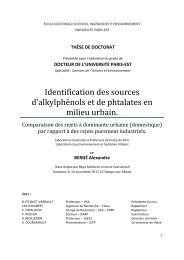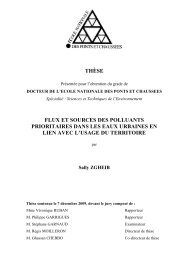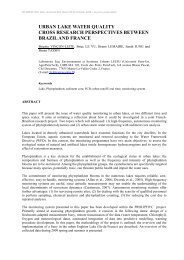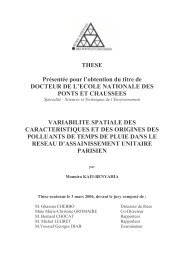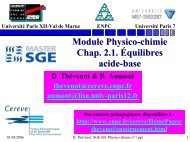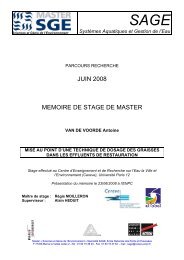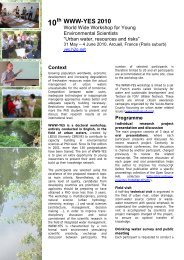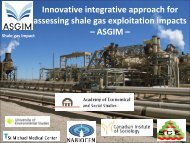Some authors such as (Eriksson et al., 2007), have established a list of pollutants called SSPPs(selected stormwater priority pollutants), to provide a clear statement on the need tackle ofnon-point source pollution in urban areas. The choice of pollutants in this list was based on atheoretically assessment of the stormwater pollutants presence called the CHIAT (ChemicalHazard Identification and Assessment Tool) methodology. It was developed within the 5 thEuropean Framework Project named Daywater (Thévenot et al., 2005) to develop anadaptation decision support system for integration of stormwater source control intosustainable urban water management strategies to support stormwater managers. The aim ofthis list was to give a valuable support for stormwater managers regarding the comparison ofvarious stormwater management strategies. However, its limitation is that it hasn’t been yetexperimentally screened on a stormwater sample.European Water frame directiveOn term of European Union rules, different lists were established since 1976. The two firstlists were included in the Directive 76/464/EEC (ECC, 1976), on pollutants that causedpollution into the aquatic environment of the Community. Then in 2000, the EU hasestablished a list for priority substances in the water policy field (EC 2000b) for which qualitystandards and measurements for the emission controls reduction will be set at Communitylevel. This list includes 33 priority substances identified as substances representing asignificant risk to or via the aquatic environment at EU level. But these pollutants wereidentified with respect to their industrial source without considering the urban ones.Choice of the 88 urban pollutantsWe found, that it seems important to evaluate not only the 33 priority pollutants of the WFDbut also we have to expand this list to include other pollutants that could be loaded in urbanareas. So we have defined a list of 88 urban pollutants included those of the WFD prioritysubstances list (2000/60/CE), those of the List 1 of dangerous substances Directive(76/464/ECC) (ECC, 1976), as well as those chosen within the others lists as described above(Eriksson et al., 2007) and those deriving from urban areas. For many organic substances ofour list, there is no information available about the concentrations in both the dissolved and theparticulate phases in the urban environment. In fact, data about priority substances instormwater remain scarce so far worldwide. The scientific literature within this field hasfocused on quality parameters (Kafi- Benyahia et al., 2008), heavy metals (Davis et al., 2001,Garnaud et al., 1999, Herngren et al., 2005, Rule et al., 2006b, Sabin et al., 2005), polycyclicaromatic hydrocarbons (PAHs) (Ngabe et al., 2000, Polkowska et al., 2000), or on a givenfamily of priority substances [PBDEs for (Kierkegaard et al., 2004, Wang et al., 2007),organotins for (Berto et al., 2007), alkylphenols for (Fries et al., 2004, Remberger et al.,2003)]. Only a few surveys deal with all the substances of the priority list on bulk samples ofwastewater or runoff (Rule et al., 2006a, Rule et al., 2006c).programme (figure 1). Each watershed presents different land use cover. These sites areequipped with stormwater separate sewer system:- Tolbiac-Massena is a 0.64 km² urban dense area in Paris centre with an impervioussurface coefficient (ISC) of 0.80 (figure 2),- Sucy-en-Brie is a 2.61 km² residential area in Paris suburb (Val de Marne) with an ISCof 0.27 (figure 3),- Noisy-le-Grand is a 2.30 km² urban centre area in Paris suburb (Seine Saint Denis)with an ICS 0.65 (figure 4).Sampling procedureAll watersheds are equipped with two similar specific sampling devices. Stormwater samplesare collected at the outlet of each watershed by refrigerated automatic water samplers (Bühler1029) to preserve sample integrity (figure 5). They are programmed to provide a mean rainevent sample. Each is equipped with 12 bottles of 1 litre. In order to avoid any interactionsbetween sampling devices and pollutants to be measured, samplers are configured as follow:- For organic pollutants, samples are collected in Pyrex amber glass bottles with Teflonsampling tubes.- For minerals substances and ordinary water quality parameters, samples were collected inpolyethylene (PE) bottles with PVC tubes.For each targeted analyses, these bottles are washed with a specific laboratory protocols.Glassware is previously thoroughly washed with TFD4 (a detergent), to remove any trace oforganic contamination, then rinsed with deionised water and finally heated at 500°C prior touse. To avoid any metallic contamination, bottles are cleaned according to the followingmethod: 24 h in a detergent bath (Extran, 5%), to remove any organic traces, then 24 h in anitric acid (5%, Normatom) bath and finally 24 h in another nitric acid (5%, Normatom) bath.Between all bathes, bottles are rinsed with ultra-pure water (MilliQ system, Millipore).All sites are equipped with ultrasonic transit time flowmeter capable of accurate measurementof depth and velocity in sewers to measure the flow variation. In order to catch the whole rainevent, data from Meteo-France are used to gauge the sampling frequency. In addition, all sitesare equipped with pluviometer to gauge exactly the quantity of precipitation on each (i.e,figure 6).So, a screening of these latter substances (88 substances, from 13 different chemical families)will be done on stormwater samples for the first time, and it will provide a concentration foreach water phase: the dissolved and the particulate. This list is detailed in table 1 (annexed).While, the pharmaceuticals and personal care products (PPCPs), which refer to prescriptionand over-the-counter therapeutic drugs, veterinary drugs, fragrances and cosmetics, werepurposely excluded from our work.Figure 1. Location of experimental sitesFigure 2. Tolbiac-Massena watershedEXPERIMENTAL SITESMonitoring campaigns for urban stormwater pollutants are carried out at the outlet of threeexperimental watersheds in Paris and its suburb, which are a part of the OPUR researchWWW-YES 2008, Paris 13 – 16 May 2008 181WWW-YES 2008, Paris 13 – 16 May 2008 182
Figure 3. Sucy-en-Brie watershedFigure 4. Noisy-le-Grand watershedSo, this research attempt at performing a whole innovative screening of the 88 listed urbanpollutants on stormwater on both the dissolved and the particulate phases. For samples withlow SS, large volume of water samples, (i.e., 24 litres) will be filtrated to collect enoughparticles for analyses. Finally, in order to compare the analyses on both dissolved andparticulate phases to the current analyses (i.e., on bulk samples), these two procedures will becarried out on the same sample.Screening preparation samplesAfter a rain event, samples are collected, and bottles are mixed to get a mean sample of theevent. From plastic bottles, sample is targeted to ordinary quality parameters and metalsanalyses while the bulk samples from glass bottles is also mixed, filtrated in a glass filtrationunit in order to get the dissolved phase for organic contaminants. This latter is sent to thecertified laboratory for analysis within 24 hours. Filters with suspended solids are deep-frozen,then lyophilized and stored at 4°C prior to analysis.The analytical procedures used by the laboratory follow the existing French (AFNOR) orinternational (ISO) standards. When no standard was available, the laboratory has developedand validated its own methods. During analysis and in case where other substances areidentified we will attempt to quantify them. In addition, field blanks will be done on automaticwater samplers and on the whole analytical procedure.Figure 5. Two automatics samplers Bühler 1029Figure 6. Pluviometer at SucySCREENING METHODOLOGYAll the analyses are carried out by a certified laboratory. This laboratory was chosen among 10laboratories that answered to our specifications and its capacity to carry analyses on these 88substances in both the dissolved and the particulate phases.Generally, when suspended solids (SS) concentration is above 500 mg/l analyses are made onthese phases separately after filtration.In most cases, analyses were made on bulk water sample without any specific analyses onsuspended solids. This case can generate a misinterpretation of the results:- Analyses carried out on unfiltered samples will provide poor-quality data with regard to therepresentativity of the contamination in water and also poor comparability between data fromdifferent laboratories (Coquery et al., 2005),- For organic pollutants having log Kp > 3, their concentration should preferably be measuredin SS rather than in the bulk water sample or dissolved phase. As a matter of fact, solventextraction of bulk water samples with high SS concentrations will be much less efficient forthose substances than if performed on the SS itself, using extraction methods designed forsolid phases, such as sediment or soil (Coquery et al., 2005).So, the results of dissolved and SS pollutant concentrations should be given separately, as suchdata are often lacking from monitoring databanks. These pose some interesting challenges foranalytical testing laboratories:- Water samples with low SS concentrations need large volumes, up to 10 litres to be filteredto get a suitable mass to perform reproducible analyses on solids,- In some cases, analytical methods have not been fully validated for the solid phase incertified laboratories whereas they are analysed in routine in research laboratories.CONCLUSIONThis research work started in November 2006 within the framework research programmeOPUR. All sampling equipments are installed on three separated sewer networks in ParisCentre and its suburb. Sampling procedures have been validated. The innovative screeningmethodology is described for the 88 urban pollutants on both the particulate and the dissolved.Analyses will be carried out by a French certified laboratory which has validated its analyticalprocedures in order to analyse for the first time stormwater samples, not only on bulk samplebut also on both the particulate and the dissolved phases. Additionally, the screening of the 88urban pollutants can be applied on different types of water samples such as wastewater fromcombined sewers collected at the outlet of urban watersheds, but also runoff from the differenttypes of urban surfaces. Effective monitoring campaigns have started on these sites. In a firstattempt, stormwater from storm sewers will be investigated followed by wastewater andrunoff. So, this research will provide the first database concentrations for the 88 pollutants indissolved and particulate phases for different kind of urban water samples collected from siteswith different land uses pattern.ACKNOWLEDGMENTSThe authors gratefully acknowledge the Seine-Normandy Water Agency (AESN), theInterdepartmental Association for Sewage Disposal in Paris Conurbation (SIAAP), the ParisMunicipality, the Water and Sewage Disposal Departmental Administrations of Seine SaintDenis (DEA93), the Water and Sewage Disposal Departmental Administration of Val deMarne (DSEA94) and Regional Council of “Ile de France” (CRIF) for their financial supportwithin the framework of the OPUR programme research.WWW-YES 2008, Paris 13 – 16 May 2008 183WWW-YES 2008, Paris 13 – 16 May 2008 184



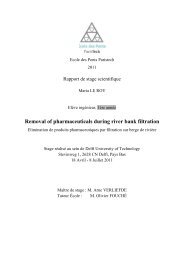
![[pastel-00730831, v1] Incidence des pratiques d'entretien ... - LEESU](https://img.yumpu.com/50938896/1/184x260/pastel-00730831-v1-incidence-des-pratiques-dentretien-leesu.jpg?quality=85)

